Business Law: Legal Systems, Impact of Law, and Legal Solutions
VerifiedAdded on 2024/06/10
|27
|6036
|59
Report
AI Summary
This business law assignment provides a detailed overview of the legal systems and legislation impacting businesses in the UK. It begins by explaining the sources of law, the role of government in law-making, and the application of common and statutory law in justice courts. The report evaluates the effectiveness of the legal system, considering recent reforms and developments. It illustrates the potential impact of company, employment, and contract law on businesses, using specific examples. Furthermore, the assignment suggests appropriate legal solutions for various business problems, such as termination of contract, insolvency, and liquidation, justifying the use of these solutions. It also recommends legal solutions based on alternative legal advice and compares the effectiveness of different legal frameworks. The report concludes by critically reviewing and evaluating the use of appropriate legal solutions in comparison with alternative legal advice.
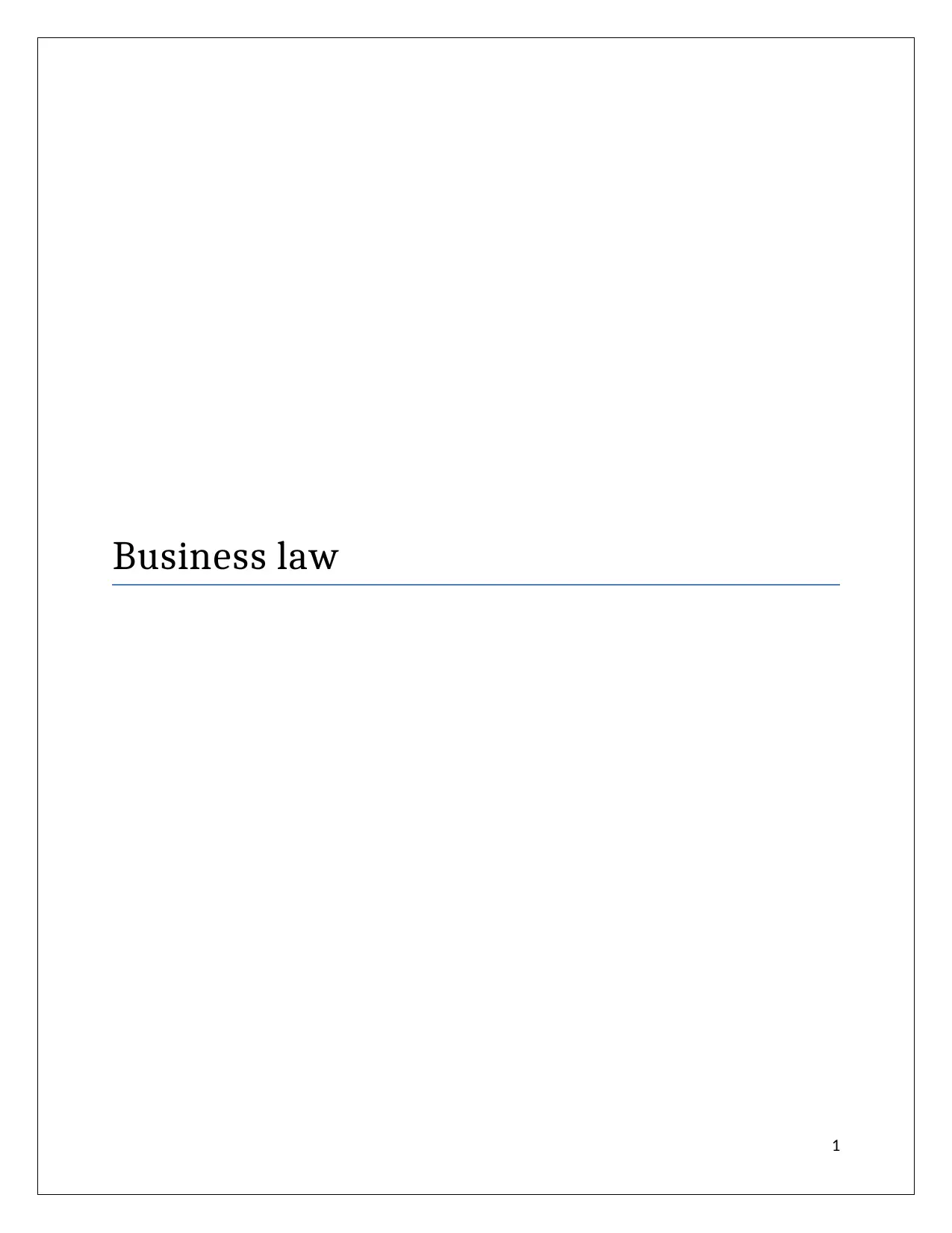
Business law
1
1
Paraphrase This Document
Need a fresh take? Get an instant paraphrase of this document with our AI Paraphraser
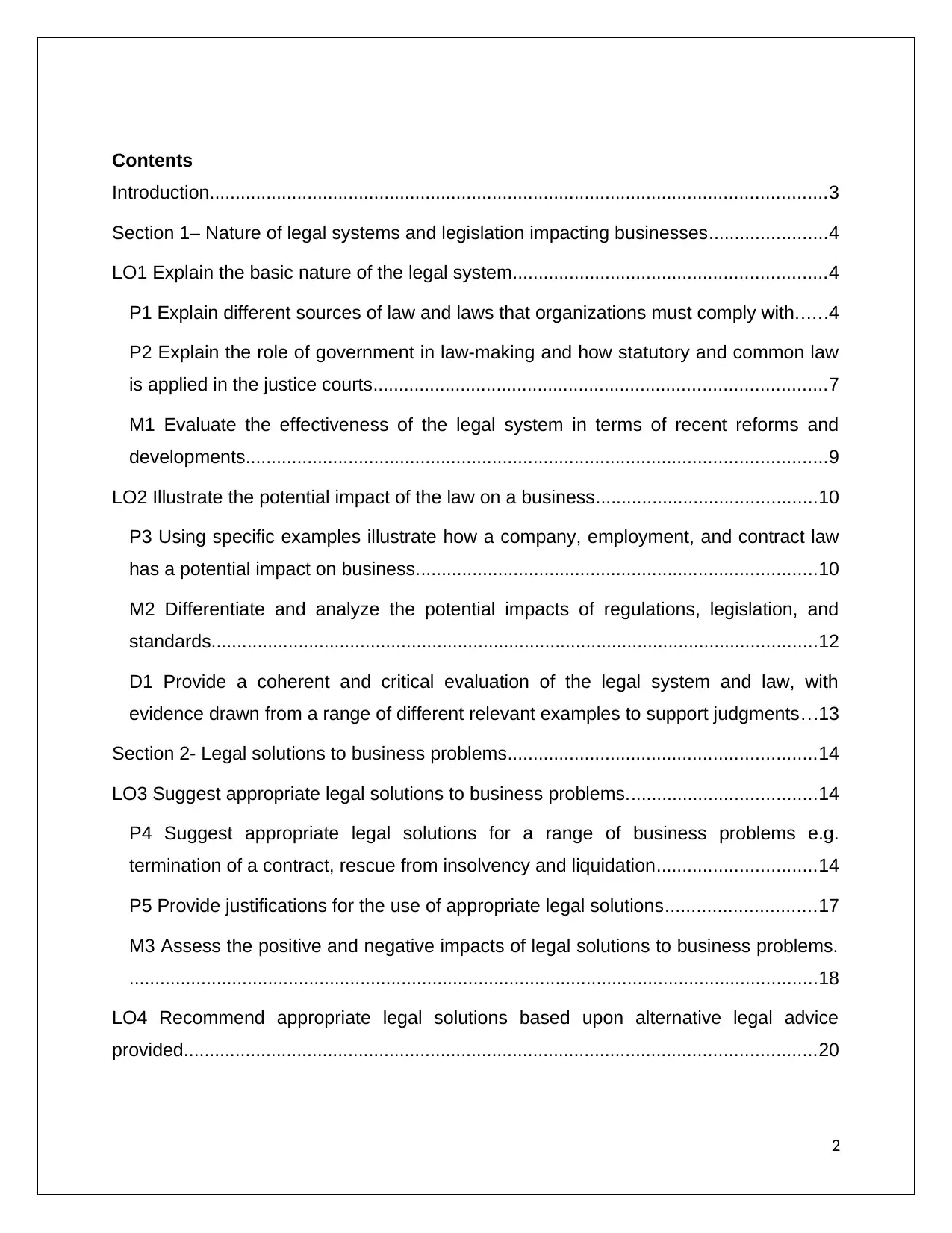
Contents
Introduction........................................................................................................................3
Section 1– Nature of legal systems and legislation impacting businesses.......................4
LO1 Explain the basic nature of the legal system.............................................................4
P1 Explain different sources of law and laws that organizations must comply with......4
P2 Explain the role of government in law-making and how statutory and common law
is applied in the justice courts........................................................................................7
M1 Evaluate the effectiveness of the legal system in terms of recent reforms and
developments.................................................................................................................9
LO2 Illustrate the potential impact of the law on a business...........................................10
P3 Using specific examples illustrate how a company, employment, and contract law
has a potential impact on business..............................................................................10
M2 Differentiate and analyze the potential impacts of regulations, legislation, and
standards......................................................................................................................12
D1 Provide a coherent and critical evaluation of the legal system and law, with
evidence drawn from a range of different relevant examples to support judgments...13
Section 2- Legal solutions to business problems............................................................14
LO3 Suggest appropriate legal solutions to business problems.....................................14
P4 Suggest appropriate legal solutions for a range of business problems e.g.
termination of a contract, rescue from insolvency and liquidation...............................14
P5 Provide justifications for the use of appropriate legal solutions.............................17
M3 Assess the positive and negative impacts of legal solutions to business problems.
......................................................................................................................................18
LO4 Recommend appropriate legal solutions based upon alternative legal advice
provided...........................................................................................................................20
2
Introduction........................................................................................................................3
Section 1– Nature of legal systems and legislation impacting businesses.......................4
LO1 Explain the basic nature of the legal system.............................................................4
P1 Explain different sources of law and laws that organizations must comply with......4
P2 Explain the role of government in law-making and how statutory and common law
is applied in the justice courts........................................................................................7
M1 Evaluate the effectiveness of the legal system in terms of recent reforms and
developments.................................................................................................................9
LO2 Illustrate the potential impact of the law on a business...........................................10
P3 Using specific examples illustrate how a company, employment, and contract law
has a potential impact on business..............................................................................10
M2 Differentiate and analyze the potential impacts of regulations, legislation, and
standards......................................................................................................................12
D1 Provide a coherent and critical evaluation of the legal system and law, with
evidence drawn from a range of different relevant examples to support judgments...13
Section 2- Legal solutions to business problems............................................................14
LO3 Suggest appropriate legal solutions to business problems.....................................14
P4 Suggest appropriate legal solutions for a range of business problems e.g.
termination of a contract, rescue from insolvency and liquidation...............................14
P5 Provide justifications for the use of appropriate legal solutions.............................17
M3 Assess the positive and negative impacts of legal solutions to business problems.
......................................................................................................................................18
LO4 Recommend appropriate legal solutions based upon alternative legal advice
provided...........................................................................................................................20
2
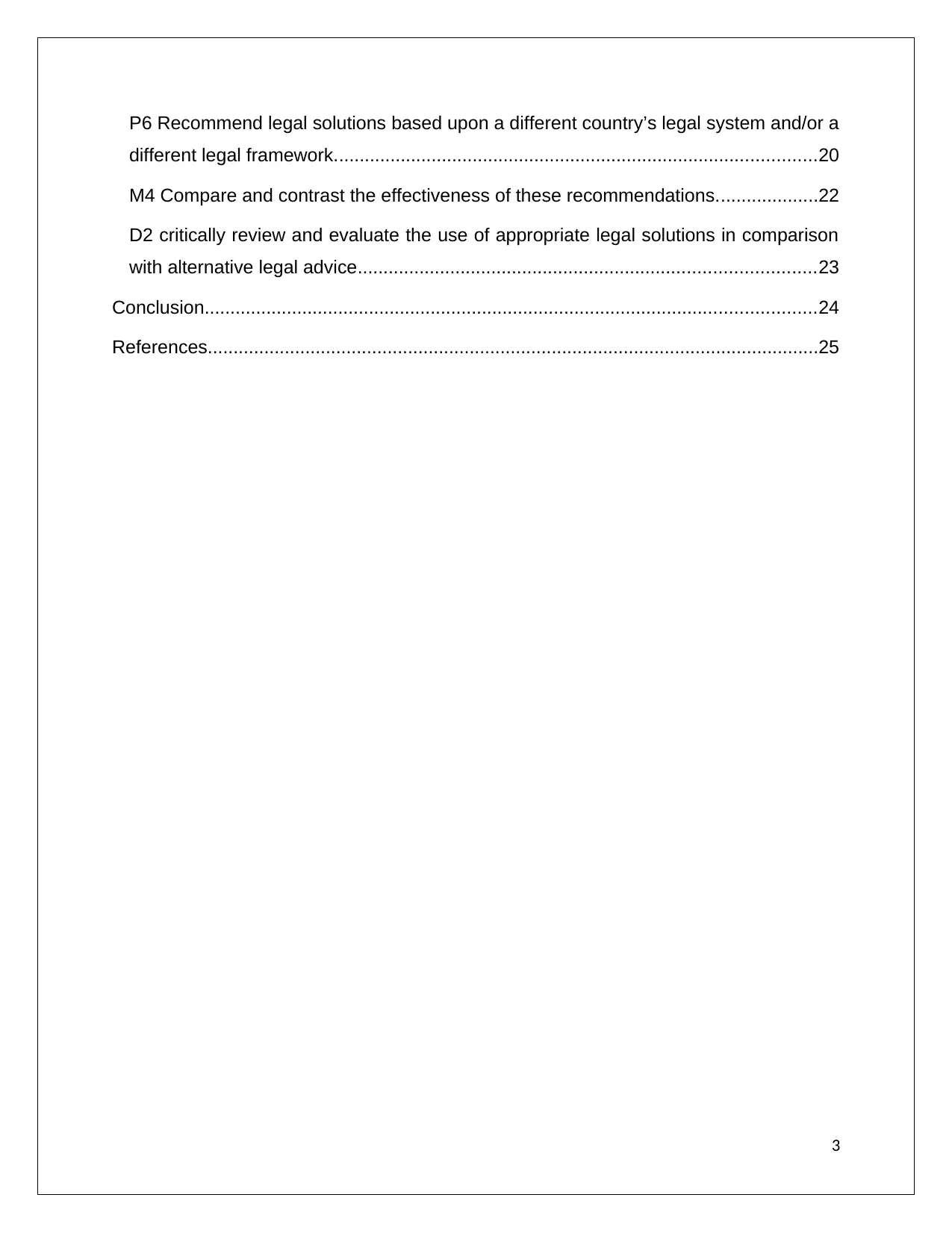
P6 Recommend legal solutions based upon a different country’s legal system and/or a
different legal framework..............................................................................................20
M4 Compare and contrast the effectiveness of these recommendations....................22
D2 critically review and evaluate the use of appropriate legal solutions in comparison
with alternative legal advice.........................................................................................23
Conclusion.......................................................................................................................24
References.......................................................................................................................25
3
different legal framework..............................................................................................20
M4 Compare and contrast the effectiveness of these recommendations....................22
D2 critically review and evaluate the use of appropriate legal solutions in comparison
with alternative legal advice.........................................................................................23
Conclusion.......................................................................................................................24
References.......................................................................................................................25
3
⊘ This is a preview!⊘
Do you want full access?
Subscribe today to unlock all pages.

Trusted by 1+ million students worldwide
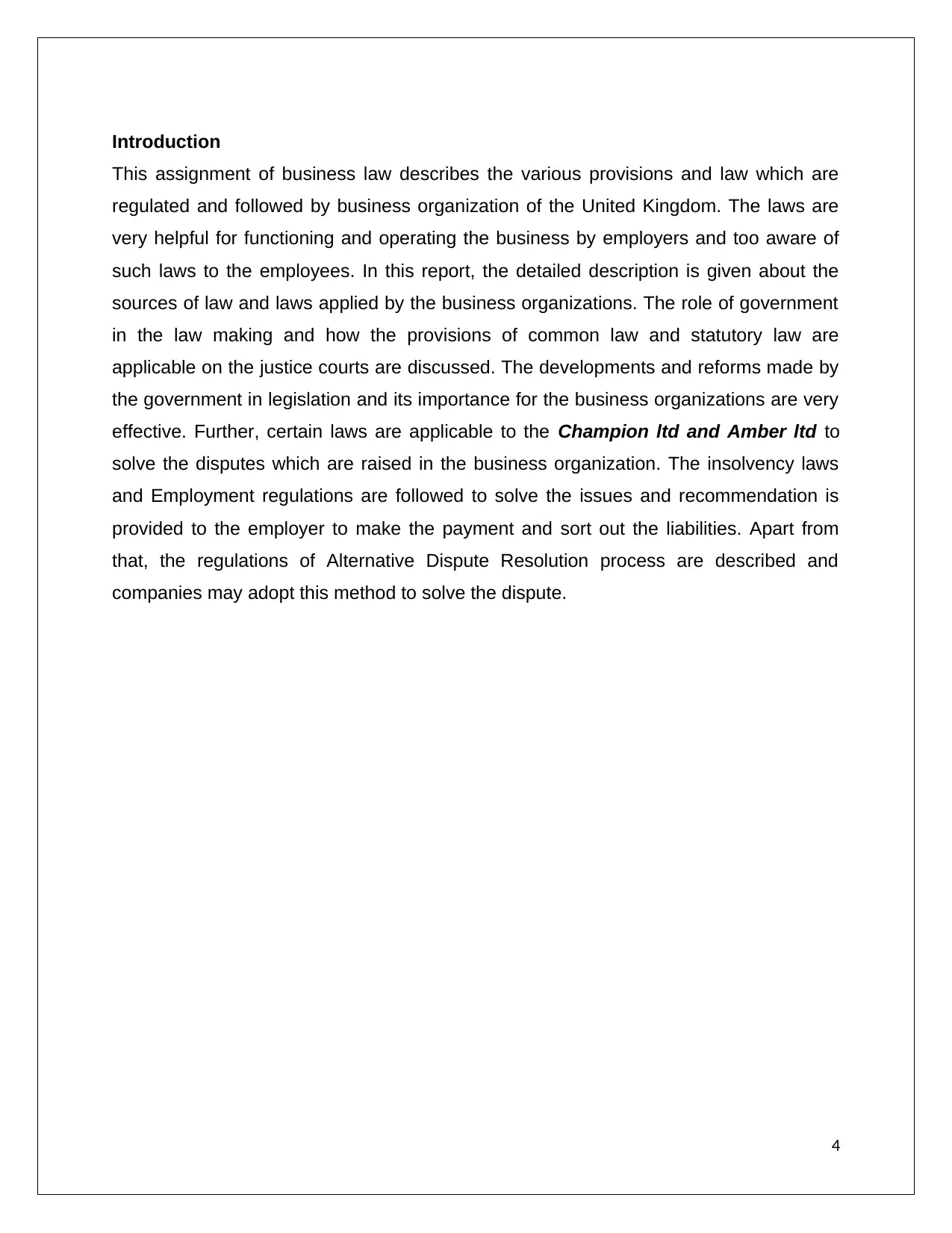
Introduction
This assignment of business law describes the various provisions and law which are
regulated and followed by business organization of the United Kingdom. The laws are
very helpful for functioning and operating the business by employers and too aware of
such laws to the employees. In this report, the detailed description is given about the
sources of law and laws applied by the business organizations. The role of government
in the law making and how the provisions of common law and statutory law are
applicable on the justice courts are discussed. The developments and reforms made by
the government in legislation and its importance for the business organizations are very
effective. Further, certain laws are applicable to the Champion ltd and Amber ltd to
solve the disputes which are raised in the business organization. The insolvency laws
and Employment regulations are followed to solve the issues and recommendation is
provided to the employer to make the payment and sort out the liabilities. Apart from
that, the regulations of Alternative Dispute Resolution process are described and
companies may adopt this method to solve the dispute.
4
This assignment of business law describes the various provisions and law which are
regulated and followed by business organization of the United Kingdom. The laws are
very helpful for functioning and operating the business by employers and too aware of
such laws to the employees. In this report, the detailed description is given about the
sources of law and laws applied by the business organizations. The role of government
in the law making and how the provisions of common law and statutory law are
applicable on the justice courts are discussed. The developments and reforms made by
the government in legislation and its importance for the business organizations are very
effective. Further, certain laws are applicable to the Champion ltd and Amber ltd to
solve the disputes which are raised in the business organization. The insolvency laws
and Employment regulations are followed to solve the issues and recommendation is
provided to the employer to make the payment and sort out the liabilities. Apart from
that, the regulations of Alternative Dispute Resolution process are described and
companies may adopt this method to solve the dispute.
4
Paraphrase This Document
Need a fresh take? Get an instant paraphrase of this document with our AI Paraphraser
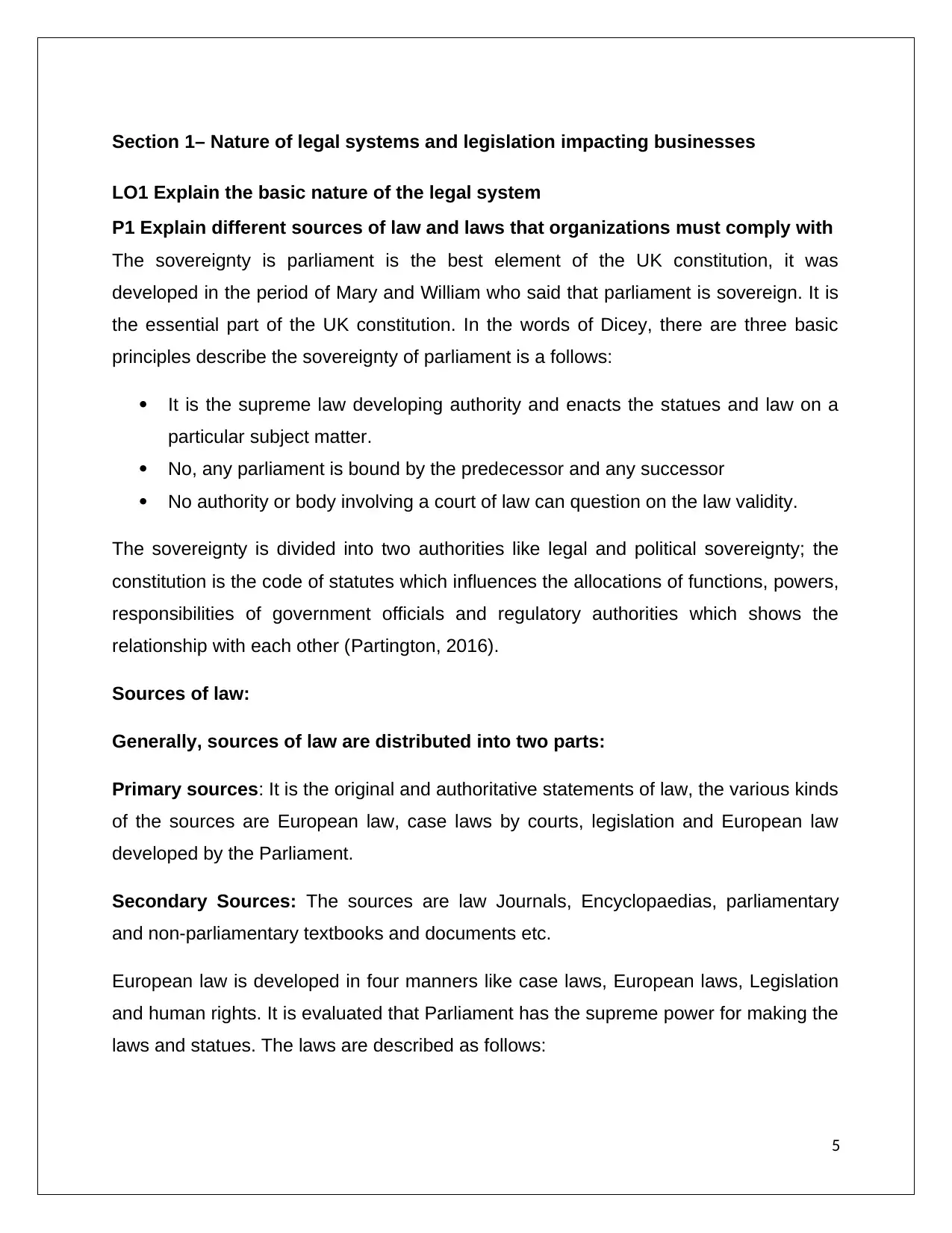
Section 1– Nature of legal systems and legislation impacting businesses
LO1 Explain the basic nature of the legal system
P1 Explain different sources of law and laws that organizations must comply with
The sovereignty is parliament is the best element of the UK constitution, it was
developed in the period of Mary and William who said that parliament is sovereign. It is
the essential part of the UK constitution. In the words of Dicey, there are three basic
principles describe the sovereignty of parliament is a follows:
It is the supreme law developing authority and enacts the statues and law on a
particular subject matter.
No, any parliament is bound by the predecessor and any successor
No authority or body involving a court of law can question on the law validity.
The sovereignty is divided into two authorities like legal and political sovereignty; the
constitution is the code of statutes which influences the allocations of functions, powers,
responsibilities of government officials and regulatory authorities which shows the
relationship with each other (Partington, 2016).
Sources of law:
Generally, sources of law are distributed into two parts:
Primary sources: It is the original and authoritative statements of law, the various kinds
of the sources are European law, case laws by courts, legislation and European law
developed by the Parliament.
Secondary Sources: The sources are law Journals, Encyclopaedias, parliamentary
and non-parliamentary textbooks and documents etc.
European law is developed in four manners like case laws, European laws, Legislation
and human rights. It is evaluated that Parliament has the supreme power for making the
laws and statues. The laws are described as follows:
5
LO1 Explain the basic nature of the legal system
P1 Explain different sources of law and laws that organizations must comply with
The sovereignty is parliament is the best element of the UK constitution, it was
developed in the period of Mary and William who said that parliament is sovereign. It is
the essential part of the UK constitution. In the words of Dicey, there are three basic
principles describe the sovereignty of parliament is a follows:
It is the supreme law developing authority and enacts the statues and law on a
particular subject matter.
No, any parliament is bound by the predecessor and any successor
No authority or body involving a court of law can question on the law validity.
The sovereignty is divided into two authorities like legal and political sovereignty; the
constitution is the code of statutes which influences the allocations of functions, powers,
responsibilities of government officials and regulatory authorities which shows the
relationship with each other (Partington, 2016).
Sources of law:
Generally, sources of law are distributed into two parts:
Primary sources: It is the original and authoritative statements of law, the various kinds
of the sources are European law, case laws by courts, legislation and European law
developed by the Parliament.
Secondary Sources: The sources are law Journals, Encyclopaedias, parliamentary
and non-parliamentary textbooks and documents etc.
European law is developed in four manners like case laws, European laws, Legislation
and human rights. It is evaluated that Parliament has the supreme power for making the
laws and statues. The laws are described as follows:
5
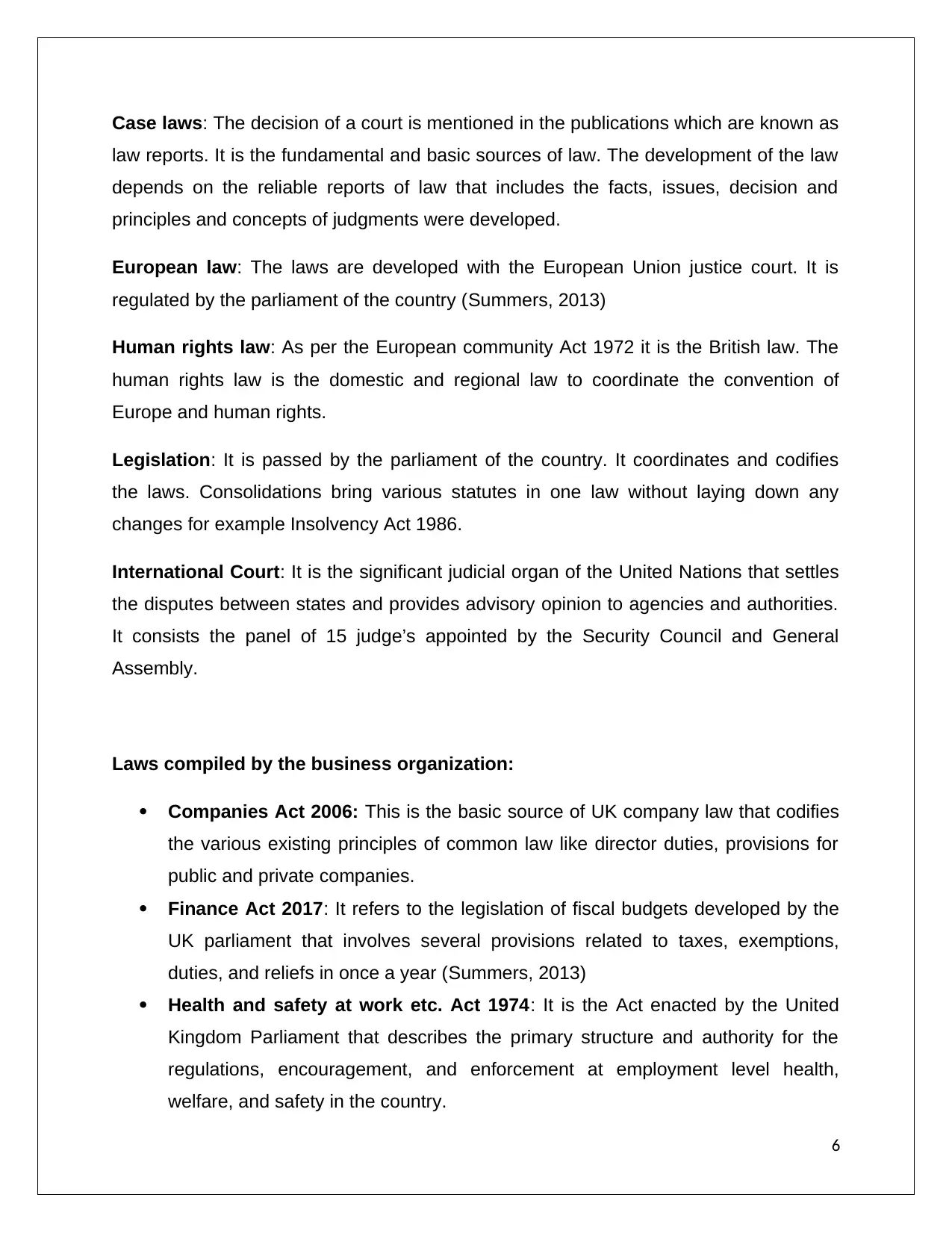
Case laws: The decision of a court is mentioned in the publications which are known as
law reports. It is the fundamental and basic sources of law. The development of the law
depends on the reliable reports of law that includes the facts, issues, decision and
principles and concepts of judgments were developed.
European law: The laws are developed with the European Union justice court. It is
regulated by the parliament of the country (Summers, 2013)
Human rights law: As per the European community Act 1972 it is the British law. The
human rights law is the domestic and regional law to coordinate the convention of
Europe and human rights.
Legislation: It is passed by the parliament of the country. It coordinates and codifies
the laws. Consolidations bring various statutes in one law without laying down any
changes for example Insolvency Act 1986.
International Court: It is the significant judicial organ of the United Nations that settles
the disputes between states and provides advisory opinion to agencies and authorities.
It consists the panel of 15 judge’s appointed by the Security Council and General
Assembly.
Laws compiled by the business organization:
Companies Act 2006: This is the basic source of UK company law that codifies
the various existing principles of common law like director duties, provisions for
public and private companies.
Finance Act 2017: It refers to the legislation of fiscal budgets developed by the
UK parliament that involves several provisions related to taxes, exemptions,
duties, and reliefs in once a year (Summers, 2013)
Health and safety at work etc. Act 1974: It is the Act enacted by the United
Kingdom Parliament that describes the primary structure and authority for the
regulations, encouragement, and enforcement at employment level health,
welfare, and safety in the country.
6
law reports. It is the fundamental and basic sources of law. The development of the law
depends on the reliable reports of law that includes the facts, issues, decision and
principles and concepts of judgments were developed.
European law: The laws are developed with the European Union justice court. It is
regulated by the parliament of the country (Summers, 2013)
Human rights law: As per the European community Act 1972 it is the British law. The
human rights law is the domestic and regional law to coordinate the convention of
Europe and human rights.
Legislation: It is passed by the parliament of the country. It coordinates and codifies
the laws. Consolidations bring various statutes in one law without laying down any
changes for example Insolvency Act 1986.
International Court: It is the significant judicial organ of the United Nations that settles
the disputes between states and provides advisory opinion to agencies and authorities.
It consists the panel of 15 judge’s appointed by the Security Council and General
Assembly.
Laws compiled by the business organization:
Companies Act 2006: This is the basic source of UK company law that codifies
the various existing principles of common law like director duties, provisions for
public and private companies.
Finance Act 2017: It refers to the legislation of fiscal budgets developed by the
UK parliament that involves several provisions related to taxes, exemptions,
duties, and reliefs in once a year (Summers, 2013)
Health and safety at work etc. Act 1974: It is the Act enacted by the United
Kingdom Parliament that describes the primary structure and authority for the
regulations, encouragement, and enforcement at employment level health,
welfare, and safety in the country.
6
⊘ This is a preview!⊘
Do you want full access?
Subscribe today to unlock all pages.

Trusted by 1+ million students worldwide
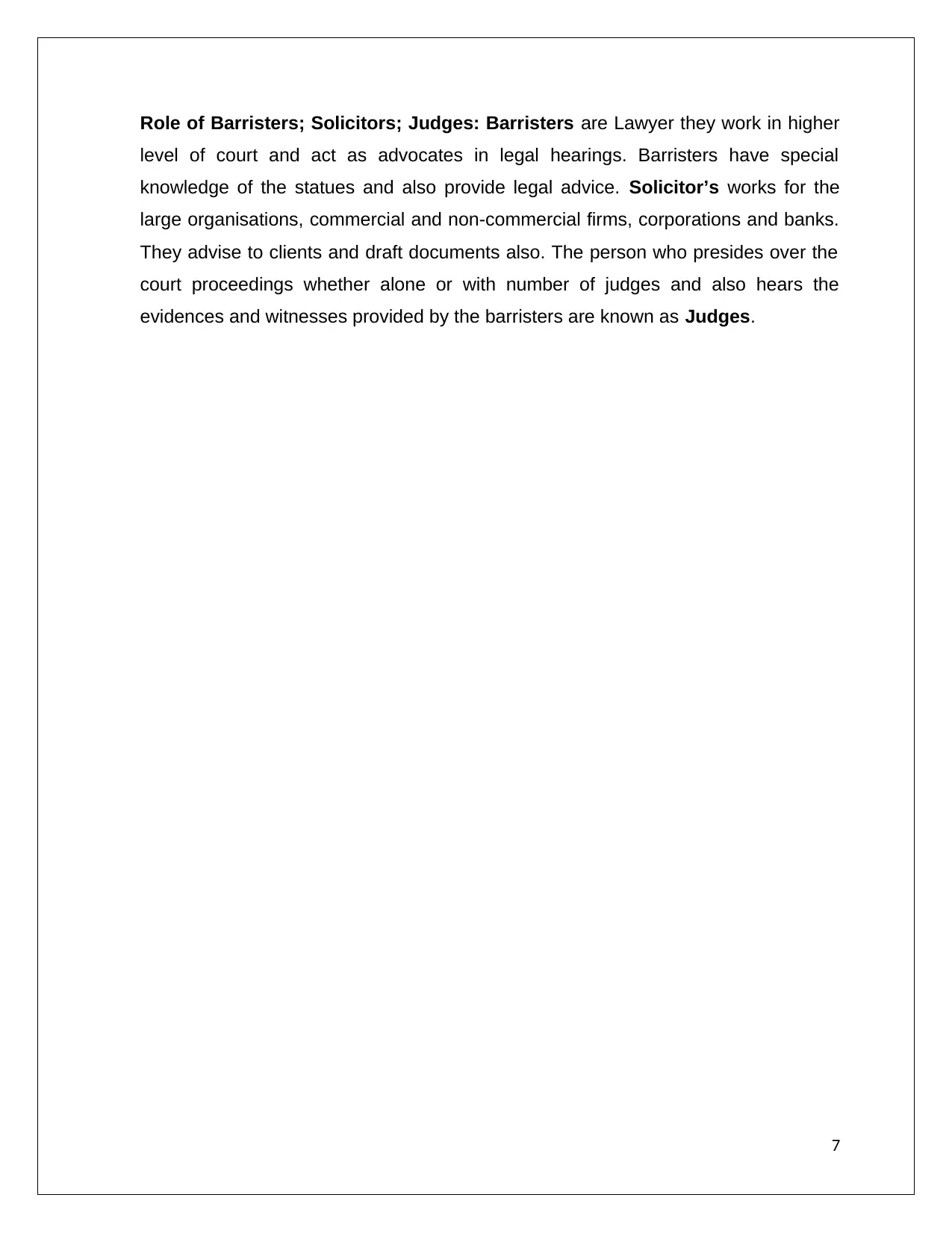
Role of Barristers; Solicitors; Judges: Barristers are Lawyer they work in higher
level of court and act as advocates in legal hearings. Barristers have special
knowledge of the statues and also provide legal advice. Solicitor’s works for the
large organisations, commercial and non-commercial firms, corporations and banks.
They advise to clients and draft documents also. The person who presides over the
court proceedings whether alone or with number of judges and also hears the
evidences and witnesses provided by the barristers are known as Judges.
7
level of court and act as advocates in legal hearings. Barristers have special
knowledge of the statues and also provide legal advice. Solicitor’s works for the
large organisations, commercial and non-commercial firms, corporations and banks.
They advise to clients and draft documents also. The person who presides over the
court proceedings whether alone or with number of judges and also hears the
evidences and witnesses provided by the barristers are known as Judges.
7
Paraphrase This Document
Need a fresh take? Get an instant paraphrase of this document with our AI Paraphraser
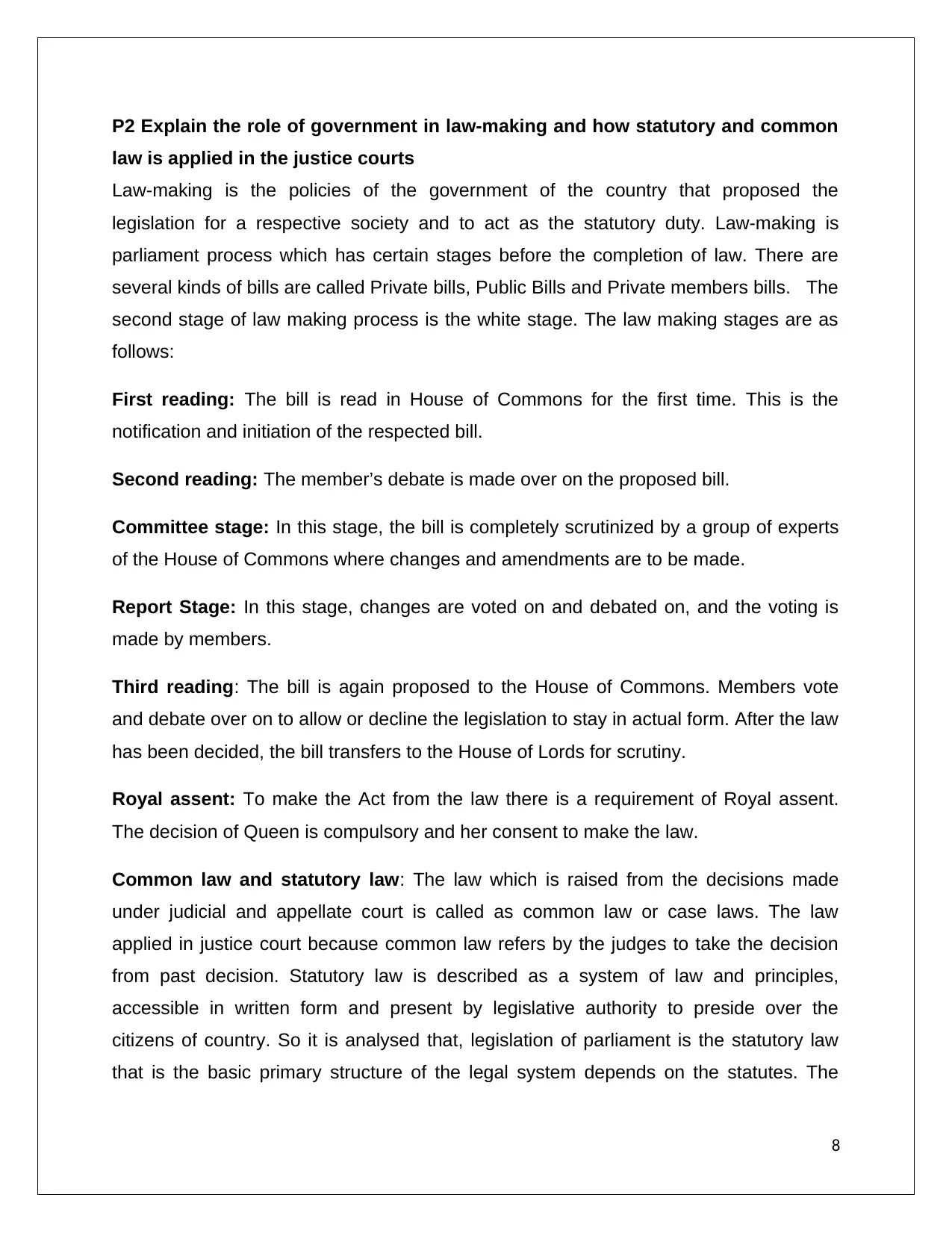
P2 Explain the role of government in law-making and how statutory and common
law is applied in the justice courts
Law-making is the policies of the government of the country that proposed the
legislation for a respective society and to act as the statutory duty. Law-making is
parliament process which has certain stages before the completion of law. There are
several kinds of bills are called Private bills, Public Bills and Private members bills. The
second stage of law making process is the white stage. The law making stages are as
follows:
First reading: The bill is read in House of Commons for the first time. This is the
notification and initiation of the respected bill.
Second reading: The member’s debate is made over on the proposed bill.
Committee stage: In this stage, the bill is completely scrutinized by a group of experts
of the House of Commons where changes and amendments are to be made.
Report Stage: In this stage, changes are voted on and debated on, and the voting is
made by members.
Third reading: The bill is again proposed to the House of Commons. Members vote
and debate over on to allow or decline the legislation to stay in actual form. After the law
has been decided, the bill transfers to the House of Lords for scrutiny.
Royal assent: To make the Act from the law there is a requirement of Royal assent.
The decision of Queen is compulsory and her consent to make the law.
Common law and statutory law: The law which is raised from the decisions made
under judicial and appellate court is called as common law or case laws. The law
applied in justice court because common law refers by the judges to take the decision
from past decision. Statutory law is described as a system of law and principles,
accessible in written form and present by legislative authority to preside over the
citizens of country. So it is analysed that, legislation of parliament is the statutory law
that is the basic primary structure of the legal system depends on the statutes. The
8
law is applied in the justice courts
Law-making is the policies of the government of the country that proposed the
legislation for a respective society and to act as the statutory duty. Law-making is
parliament process which has certain stages before the completion of law. There are
several kinds of bills are called Private bills, Public Bills and Private members bills. The
second stage of law making process is the white stage. The law making stages are as
follows:
First reading: The bill is read in House of Commons for the first time. This is the
notification and initiation of the respected bill.
Second reading: The member’s debate is made over on the proposed bill.
Committee stage: In this stage, the bill is completely scrutinized by a group of experts
of the House of Commons where changes and amendments are to be made.
Report Stage: In this stage, changes are voted on and debated on, and the voting is
made by members.
Third reading: The bill is again proposed to the House of Commons. Members vote
and debate over on to allow or decline the legislation to stay in actual form. After the law
has been decided, the bill transfers to the House of Lords for scrutiny.
Royal assent: To make the Act from the law there is a requirement of Royal assent.
The decision of Queen is compulsory and her consent to make the law.
Common law and statutory law: The law which is raised from the decisions made
under judicial and appellate court is called as common law or case laws. The law
applied in justice court because common law refers by the judges to take the decision
from past decision. Statutory law is described as a system of law and principles,
accessible in written form and present by legislative authority to preside over the
citizens of country. So it is analysed that, legislation of parliament is the statutory law
that is the basic primary structure of the legal system depends on the statutes. The
8
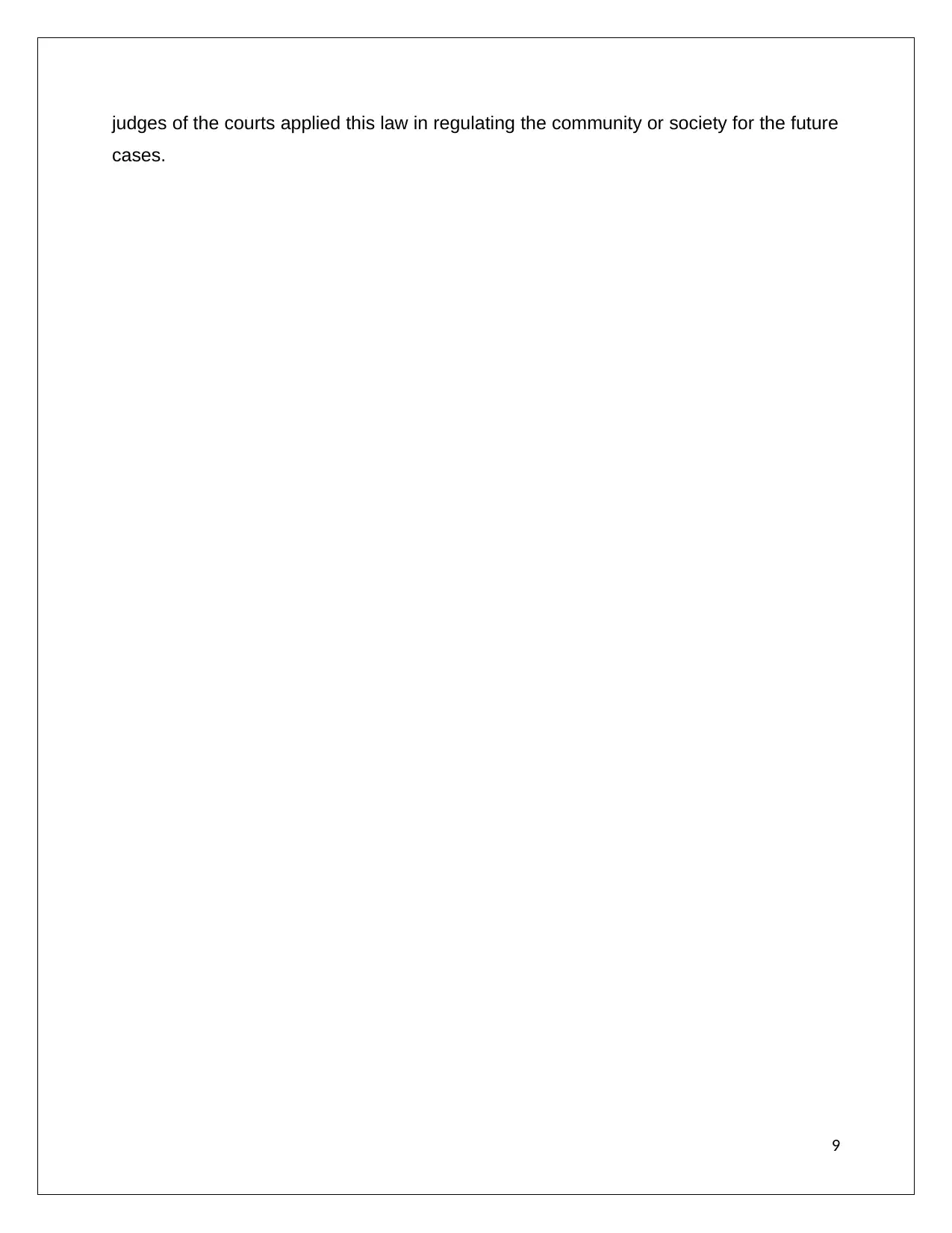
judges of the courts applied this law in regulating the community or society for the future
cases.
9
cases.
9
⊘ This is a preview!⊘
Do you want full access?
Subscribe today to unlock all pages.

Trusted by 1+ million students worldwide
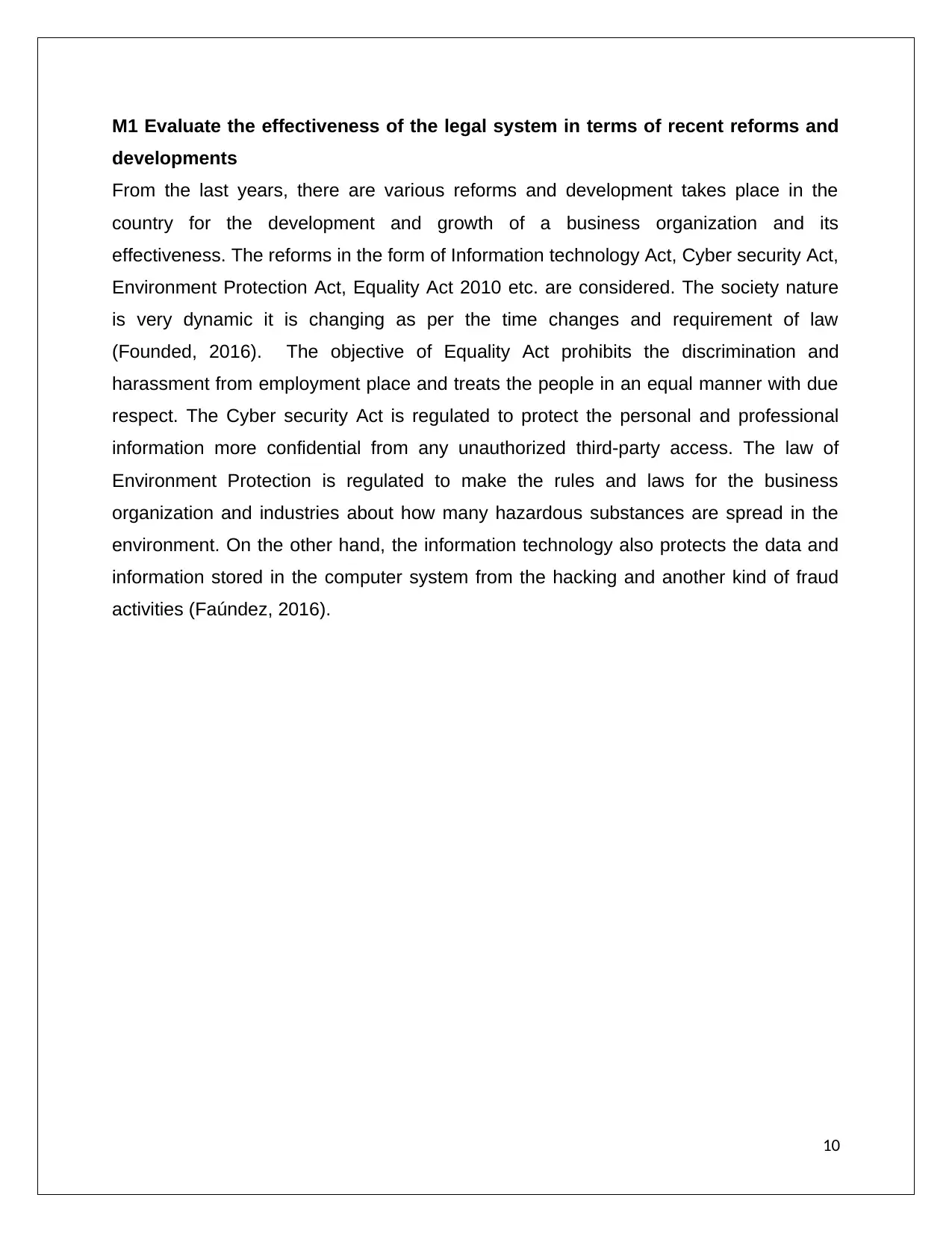
M1 Evaluate the effectiveness of the legal system in terms of recent reforms and
developments
From the last years, there are various reforms and development takes place in the
country for the development and growth of a business organization and its
effectiveness. The reforms in the form of Information technology Act, Cyber security Act,
Environment Protection Act, Equality Act 2010 etc. are considered. The society nature
is very dynamic it is changing as per the time changes and requirement of law
(Founded, 2016). The objective of Equality Act prohibits the discrimination and
harassment from employment place and treats the people in an equal manner with due
respect. The Cyber security Act is regulated to protect the personal and professional
information more confidential from any unauthorized third-party access. The law of
Environment Protection is regulated to make the rules and laws for the business
organization and industries about how many hazardous substances are spread in the
environment. On the other hand, the information technology also protects the data and
information stored in the computer system from the hacking and another kind of fraud
activities (Faúndez, 2016).
10
developments
From the last years, there are various reforms and development takes place in the
country for the development and growth of a business organization and its
effectiveness. The reforms in the form of Information technology Act, Cyber security Act,
Environment Protection Act, Equality Act 2010 etc. are considered. The society nature
is very dynamic it is changing as per the time changes and requirement of law
(Founded, 2016). The objective of Equality Act prohibits the discrimination and
harassment from employment place and treats the people in an equal manner with due
respect. The Cyber security Act is regulated to protect the personal and professional
information more confidential from any unauthorized third-party access. The law of
Environment Protection is regulated to make the rules and laws for the business
organization and industries about how many hazardous substances are spread in the
environment. On the other hand, the information technology also protects the data and
information stored in the computer system from the hacking and another kind of fraud
activities (Faúndez, 2016).
10
Paraphrase This Document
Need a fresh take? Get an instant paraphrase of this document with our AI Paraphraser
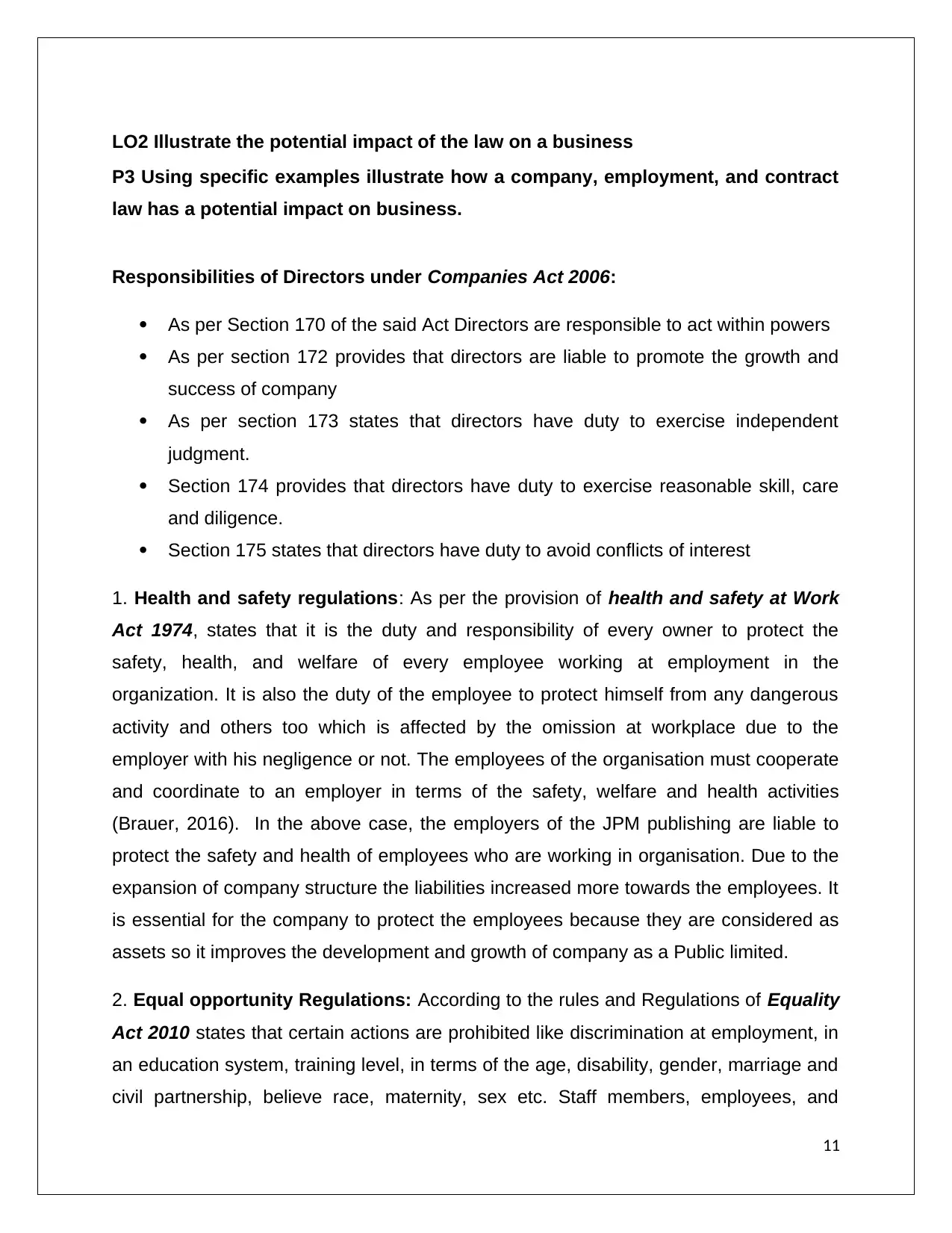
LO2 Illustrate the potential impact of the law on a business
P3 Using specific examples illustrate how a company, employment, and contract
law has a potential impact on business.
Responsibilities of Directors under Companies Act 2006:
As per Section 170 of the said Act Directors are responsible to act within powers
As per section 172 provides that directors are liable to promote the growth and
success of company
As per section 173 states that directors have duty to exercise independent
judgment.
Section 174 provides that directors have duty to exercise reasonable skill, care
and diligence.
Section 175 states that directors have duty to avoid conflicts of interest
1. Health and safety regulations: As per the provision of health and safety at Work
Act 1974, states that it is the duty and responsibility of every owner to protect the
safety, health, and welfare of every employee working at employment in the
organization. It is also the duty of the employee to protect himself from any dangerous
activity and others too which is affected by the omission at workplace due to the
employer with his negligence or not. The employees of the organisation must cooperate
and coordinate to an employer in terms of the safety, welfare and health activities
(Brauer, 2016). In the above case, the employers of the JPM publishing are liable to
protect the safety and health of employees who are working in organisation. Due to the
expansion of company structure the liabilities increased more towards the employees. It
is essential for the company to protect the employees because they are considered as
assets so it improves the development and growth of company as a Public limited.
2. Equal opportunity Regulations: According to the rules and Regulations of Equality
Act 2010 states that certain actions are prohibited like discrimination at employment, in
an education system, training level, in terms of the age, disability, gender, marriage and
civil partnership, believe race, maternity, sex etc. Staff members, employees, and
11
P3 Using specific examples illustrate how a company, employment, and contract
law has a potential impact on business.
Responsibilities of Directors under Companies Act 2006:
As per Section 170 of the said Act Directors are responsible to act within powers
As per section 172 provides that directors are liable to promote the growth and
success of company
As per section 173 states that directors have duty to exercise independent
judgment.
Section 174 provides that directors have duty to exercise reasonable skill, care
and diligence.
Section 175 states that directors have duty to avoid conflicts of interest
1. Health and safety regulations: As per the provision of health and safety at Work
Act 1974, states that it is the duty and responsibility of every owner to protect the
safety, health, and welfare of every employee working at employment in the
organization. It is also the duty of the employee to protect himself from any dangerous
activity and others too which is affected by the omission at workplace due to the
employer with his negligence or not. The employees of the organisation must cooperate
and coordinate to an employer in terms of the safety, welfare and health activities
(Brauer, 2016). In the above case, the employers of the JPM publishing are liable to
protect the safety and health of employees who are working in organisation. Due to the
expansion of company structure the liabilities increased more towards the employees. It
is essential for the company to protect the employees because they are considered as
assets so it improves the development and growth of company as a Public limited.
2. Equal opportunity Regulations: According to the rules and Regulations of Equality
Act 2010 states that certain actions are prohibited like discrimination at employment, in
an education system, training level, in terms of the age, disability, gender, marriage and
civil partnership, believe race, maternity, sex etc. Staff members, employees, and
11
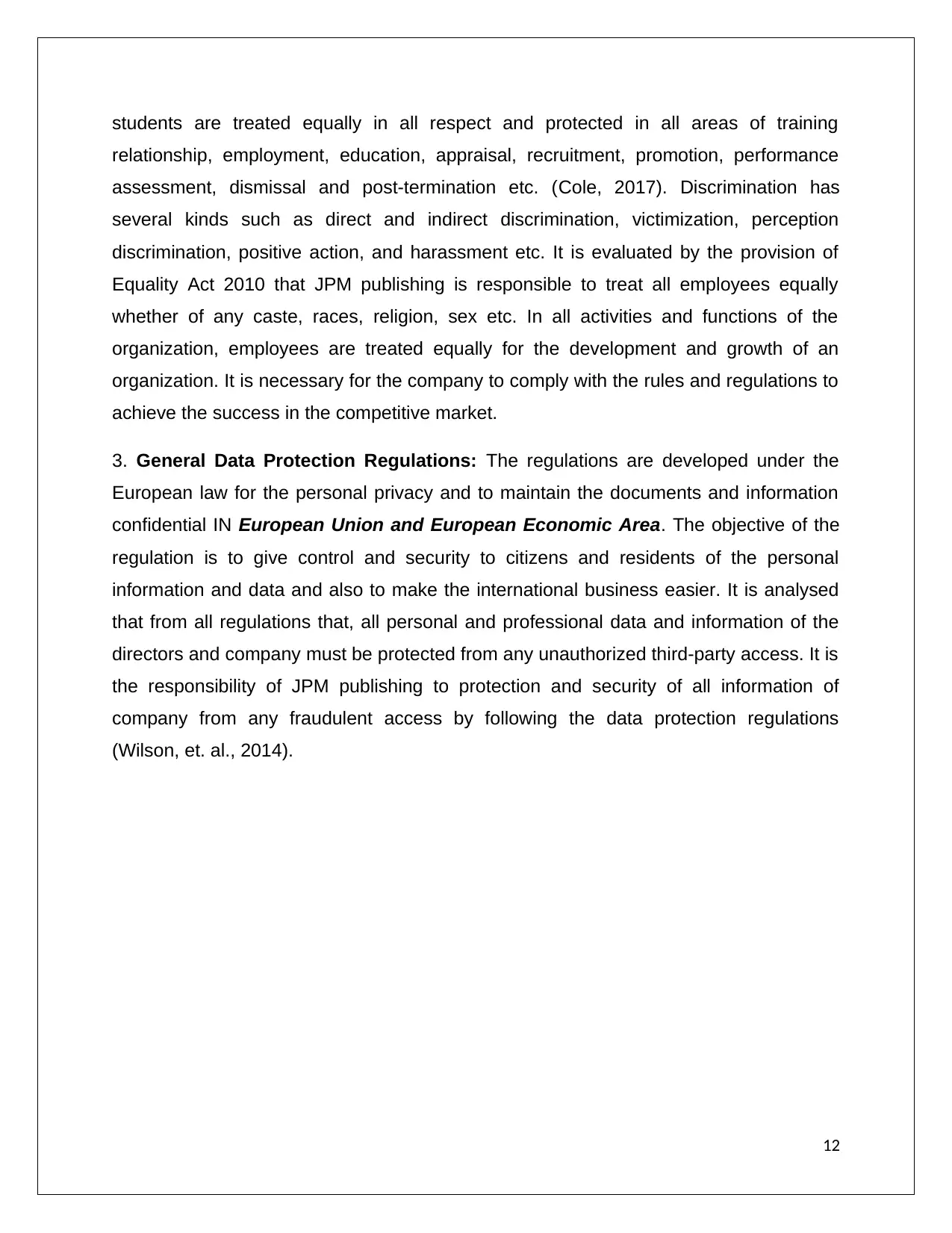
students are treated equally in all respect and protected in all areas of training
relationship, employment, education, appraisal, recruitment, promotion, performance
assessment, dismissal and post-termination etc. (Cole, 2017). Discrimination has
several kinds such as direct and indirect discrimination, victimization, perception
discrimination, positive action, and harassment etc. It is evaluated by the provision of
Equality Act 2010 that JPM publishing is responsible to treat all employees equally
whether of any caste, races, religion, sex etc. In all activities and functions of the
organization, employees are treated equally for the development and growth of an
organization. It is necessary for the company to comply with the rules and regulations to
achieve the success in the competitive market.
3. General Data Protection Regulations: The regulations are developed under the
European law for the personal privacy and to maintain the documents and information
confidential IN European Union and European Economic Area. The objective of the
regulation is to give control and security to citizens and residents of the personal
information and data and also to make the international business easier. It is analysed
that from all regulations that, all personal and professional data and information of the
directors and company must be protected from any unauthorized third-party access. It is
the responsibility of JPM publishing to protection and security of all information of
company from any fraudulent access by following the data protection regulations
(Wilson, et. al., 2014).
12
relationship, employment, education, appraisal, recruitment, promotion, performance
assessment, dismissal and post-termination etc. (Cole, 2017). Discrimination has
several kinds such as direct and indirect discrimination, victimization, perception
discrimination, positive action, and harassment etc. It is evaluated by the provision of
Equality Act 2010 that JPM publishing is responsible to treat all employees equally
whether of any caste, races, religion, sex etc. In all activities and functions of the
organization, employees are treated equally for the development and growth of an
organization. It is necessary for the company to comply with the rules and regulations to
achieve the success in the competitive market.
3. General Data Protection Regulations: The regulations are developed under the
European law for the personal privacy and to maintain the documents and information
confidential IN European Union and European Economic Area. The objective of the
regulation is to give control and security to citizens and residents of the personal
information and data and also to make the international business easier. It is analysed
that from all regulations that, all personal and professional data and information of the
directors and company must be protected from any unauthorized third-party access. It is
the responsibility of JPM publishing to protection and security of all information of
company from any fraudulent access by following the data protection regulations
(Wilson, et. al., 2014).
12
⊘ This is a preview!⊘
Do you want full access?
Subscribe today to unlock all pages.

Trusted by 1+ million students worldwide
1 out of 27
Related Documents
Your All-in-One AI-Powered Toolkit for Academic Success.
+13062052269
info@desklib.com
Available 24*7 on WhatsApp / Email
![[object Object]](/_next/static/media/star-bottom.7253800d.svg)
Unlock your academic potential
Copyright © 2020–2025 A2Z Services. All Rights Reserved. Developed and managed by ZUCOL.





